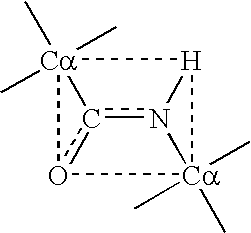Modified interleukin-1 receptor antagonist(il-1ra) with reduced immunogenicity
a technology of interleukin-1 receptor and immunogenicity, which is applied in the field of modified interleukin-1 receptor antagonists with reduced immunogenicity, can solve the problems of limited therapeutic effect of peptides and may not function as t-cell epitopes in all situations, and achieves substantial reduction or elimination of the activity of t-cell epitopes, reduce immunogenic potential, and reduce the effect of activity
- Summary
- Abstract
- Description
- Claims
- Application Information
AI Technical Summary
Benefits of technology
Problems solved by technology
Method used
Image
Examples
Embodiment Construction
[0062] There are a number of factors that play important roles in determining the total structure of a protein or polypeptide. First, the peptide bond, i.e., that bond which joins the amino acids in the chain together, is a covalent bond. This bond is planar in structure, essentially a substituted amide. An "amide" is any of a group of organic compounds containing the grouping --CONH--.
[0063] The planar peptide bond linking C.alpha. of adjacent amino acids may be represented as depicted below: 1
[0064] Because the O.dbd.C and the C--N atoms lie in a relatively rigid plane, free rotation does not occur about these axes. Hence, a plane schematically depicted by the interrupted line is sometimes referred to as an "amide" or "peptide plane" plane wherein lie the oxygen (O), carbon (C), nitrogen (N), and hydrogen (H) atoms of the peptide backbone. At opposite corners of this amide plane are located the C.alpha. atoms. Since there is substantially no rotation about the O.dbd.C and C--N ato...
PUM
| Property | Measurement | Unit |
|---|---|---|
| optimal distance | aaaaa | aaaaa |
| hydrogen bond angle | aaaaa | aaaaa |
| size | aaaaa | aaaaa |
Abstract
Description
Claims
Application Information
 Login to View More
Login to View More - R&D
- Intellectual Property
- Life Sciences
- Materials
- Tech Scout
- Unparalleled Data Quality
- Higher Quality Content
- 60% Fewer Hallucinations
Browse by: Latest US Patents, China's latest patents, Technical Efficacy Thesaurus, Application Domain, Technology Topic, Popular Technical Reports.
© 2025 PatSnap. All rights reserved.Legal|Privacy policy|Modern Slavery Act Transparency Statement|Sitemap|About US| Contact US: help@patsnap.com


